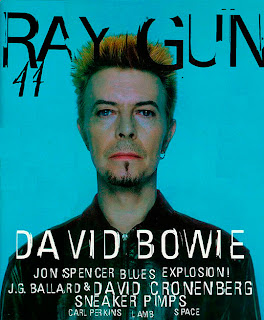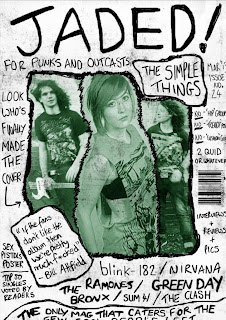7. Looking back at your preliminary task (the continuity editing task), what do you feel you have learnt in the progression from it to full product?
Since my preliminary task, I have enhanced my ability to use different software and technologies, as well as understanding the certain conventions and expectations of exisiting products and what makes a magazine appealing to an audience. Before completing this project, my skills on Photoshop were very limited and basic. However, since my preliminary work, I have become accustomed to how it works and the best way to use this to my advantage. I have learnt to use tools such as the 'magic wand' to erase the background from an image, as well as the 'lasso' tool, which meant that I could cut around an image almost perfectly. As you can see from my preliminary work, I did not know how to do this, and so the background is grey because that was the background of the image. I had to stretch the photo to fit the entire page, which was especially a problem when creating my contents page, and so ended up distorting the image just to fill the background.
When the time came to create my draft magazine, I still hadn't understood how to cut around an image with the lasso tool, although this didn't necessarily affect what I wanted to do much as it had with my preliminary, as I chose to keep the arty background within the image of my artist. I resized this and decided to use a plain white background to place the text over.
However, my final idea required a lot of cutting around several images, as I wanted my magazine to look particularly handmade in the style of a punk fanzine. In the transition from my draft to my final piece, I practiced cutting images out using the lasso tool and had also used the magic wand tool during the process of my draft cover, which enabled me to change the colour of the background behind my image, as it deleted the fill of the photograph.
In preparation for my final magazine, I spent a lot of time on Photoshop editing photos separately. This way I could decide how best to present my models and how they would fit on the page before creating the actual product. As I wanted all of my images to be separate, despite having taken my photographs of the band together, I had to look at each photograph and decide which image of each model was best and if I was able to cut it out from the images I had to work with. In the bottom left screen shot, I used only two images, and cut out the model on the right from the photo and chose another in which he had used better poses.
In the bottom right screen shot, however, I decided to change the image of the two models together because I didn't feel like they were right, and so I cut out two separate images this time and positioned them accordingly. I place the female model in the middle and slightly in front of the male band members, so as to create a natural look about the new image I had created. I played around with several different effects until I was happy with the way the images looked, and then saved them as one image.
This made the process of adding them to a separate document in which I was creating my contents page a lot easier (image below).
During the early stages of the project, I had never come across a punk fanzine in my life, and so my research and planning was vital in creating my final product. To being with, I was only aware of mainstream magazines such as NME, Q, Rolling Stone, Kerrang! etc. and so I thought my ideas were going to be limited. Having scowered the internet for other types of magazines, however, I came across some less well known magazines such as Raygun and developed my ideas from there, as I liked the style of this.

Having come across Sniffin' Glue, however, I decided to change my ideas again, and as my draft magazine had not ended up as I wanted it, I decided to completely push the boundaries and abandon all conventions of traditional magazines. The language register used in my draft articles and my preliminary work was very wishy-washy, and didn't really fit a particular genre. However, from the jump to my final piece, I amended this and began writing in a very particular way, including controversial headlines such as 'NO - 'hip' groups' and not shying away from taboo and slang, so as to conform to the punk style. From Sniffin' Glue, I found fanzines such as Sunday Mirra, Ripped & Torn and British Underground. I liked that these zines were handmade and looked messy, and so I adopted this style, but made my magazine look slightly more professional, as I continued to use Photoshop to create this image. As I was unaware of how to find fonts which looked similar to a 'drawn on' style, one of my teachers recommended I use the Bamboo Pen tablet, which would enable me to use the pen tool on Photoshop and draw onto the page digitally.


During my preliminary work, I did not focus on the mise-en-scene when taking photographs, as I was unexperienced within this field and did not know how best to go about taking photos. I used the school studio and one of my friends and quickly took a few photos to work with. However, during the drafting process of my magazine, I began to explore certain ideas and decided to take photos in a range of places, having thought long and hard about who I was going to take photos of. I took a more considerable amount of photos for my draft magazine than I did for the preliminary task, so that I had a range to choose from with various poses and costume choices.

When it came to my final piece, I set up the AV studio to compliment my models, chose what I wanted them to wear, and photographed them in front of the plain backdrop knowing exactly how I wanted them to look. I abandoned the idea of taking photos outside because of the weather and because it would make editing a lot easier if the models were in front of a white background.

Throughtout the production of my product, I feel that I have gradually progressed since my preliminary work and my draft magazine, and that my final magazine is much more effective and professional. The precision of my editing is of a much higher standard than my previous work, and I definitely feel like I have improved throughout the project.







a great response. you've covered all the key areas well.
ReplyDelete